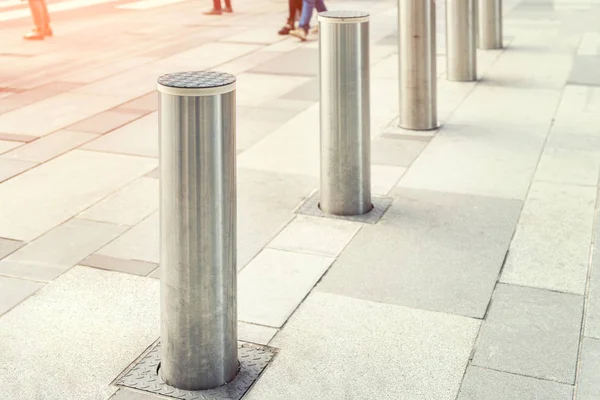Hydraulic bollards are robust security installations used in urban environments to control vehicle access, enhance pedestrian safety, and protect sensitive areas. These retractable barriers operate using hydraulic mechanisms, which enable them to rise and lower as needed to permit or restrict vehicle passage. Installing hydraulic bollards involves navigating various regulatory considerations to ensure compliance with safety standards, urban planning regulations, and environmental guidelines. This article explores the regulatory landscape surrounding the installation of hydraulic bollards, highlighting key considerations and best practices. Additionally, it discusses the role of components such as hydraulic piston seal in maintaining the operational integrity and longevity of these security systems.
Understanding Hydraulic Bollards
Hydraulic bollards are sturdy, retractable posts typically made from steel or reinforced materials. They are installed flush with the ground and can be raised or lowered via hydraulic pistons. These bollards serve multiple purposes, including:
– Security: Preventing unauthorized vehicle access to pedestrian zones, public spaces, and sensitive infrastructure.
– Traffic Control: Regulating vehicle flow in urban areas, particularly during events or emergencies.
– Aesthetic Integration: Enhancing the visual appeal of streetscapes and public spaces without compromising safety.
Components of Hydraulic Bollards
Hydraulic bollards consist of several essential components:
– Hydraulic Piston: The core mechanism responsible for raising and lowering the bollard.
– Control System: Manages the operation of the hydraulic piston and integrates with access control systems or traffic management solutions.
– Bollard Casing: Outer shell made of durable materials such as stainless steel or concrete, providing physical protection and durability.
– Safety Features: Sensors, lights, and audible alarms to alert pedestrians and drivers during bollard operation.
Regulatory Landscape
Installing hydraulic bollards involves compliance with a range of regulatory requirements and considerations:
1. Safety Standards
Hydraulic bollards must meet stringent safety standards to prevent accidents and ensure reliability:
– Impact Resistance: Bollards should withstand vehicle impacts without compromising structural integrity, protecting pedestrians and surrounding infrastructure.
– Emergency Override: Incorporating fail-safe mechanisms to manually override hydraulic operations during power outages or emergencies.
2. Urban Planning and Zoning Regulations
Local zoning laws and urban planning regulations dictate where and how hydraulic bollards can be installed:
– Pedestrian Access: Ensuring bollards do not obstruct pedestrian pathways or emergency access routes.
– Historic Preservation: Complying with preservation guidelines in historic districts to maintain architectural integrity.
3. Environmental Considerations
Installing hydraulic bollards may require environmental impact assessments and compliance with sustainability guidelines:
– Stormwater Management: Addressing drainage and runoff considerations to prevent environmental harm.
– Green Building Standards: Using eco-friendly materials and energy-efficient components where possible.
4. Accessibility Requirements
Ensuring hydraulic bollards do not hinder accessibility for persons with disabilities:
– ADA Compliance: Maintaining accessible pathways and incorporating features like audible signals for visually impaired individuals.
5. Permitting and Approval Processes
Securing necessary permits and approvals from local authorities and regulatory bodies:
– Traffic Management Plans: Submitting detailed plans for bollard installation, operation, and maintenance.
– Public Consultation: Engaging stakeholders, including residents and businesses, to address concerns and gather feedback.
Role of Hydraulic Piston Seals
Hydraulic piston seals are critical components in maintaining the operational efficiency and longevity of hydraulic bollards:
– Sealing Performance: Preventing hydraulic fluid leaks and maintaining pressure integrity within the hydraulic system.
– Durability: Withstanding frequent use and environmental conditions, such as temperature fluctuations and moisture.
– Maintenance: Regular inspection and replacement of hydraulic piston seals to prevent operational failures and ensure consistent performance.
Best Practices for Installation
To navigate regulatory considerations effectively when installing hydraulic bollards, adhere to these best practices:
– Consultation: Engage with regulatory authorities early in the planning process to understand specific requirements and obtain necessary approvals.
– Comprehensive Design: Ensure hydraulic bollard designs incorporate safety features, accessibility provisions, and environmental considerations.
– Professional Installation: Hire qualified contractors experienced in hydraulic systems and structural installations to ensure compliance with safety and operational standards.
– Regular Maintenance: Implement a proactive maintenance schedule, including inspection of hydraulic components like piston seals, to prolong bollard lifespan and optimize performance.
Case Studies: Successful Implementation
Case Study 1: City Center Plaza, Urban Redevelopment Project
In a city center plaza redevelopment project, hydraulic bollards were installed to enhance security while preserving pedestrian access. Compliance with local safety standards and zoning regulations ensured seamless integration into the urban landscape, supporting revitalization efforts and community safety initiatives.
Case Study 2: Historic District Preservation, Old Town Restoration
In an old town restoration project, hydraulic bollards were installed in compliance with historic preservation guidelines to protect pedestrian zones and heritage buildings. Collaboration with preservation authorities and community stakeholders ensured minimal impact on architectural aesthetics and cultural heritage.
Future Trends and Innovations
As technology advances, future trends in hydraulic bollards focus on:
– Smart Integration: IoT-enabled bollards for real-time monitoring, remote operation, and data analytics.
– Environmental Sustainability: Integration of renewable energy sources and eco-friendly materials in bollard design and operation.
– Enhanced Safety Features: Advanced sensors and AI-driven systems for predictive maintenance and adaptive security protocols.
Conclusion
Navigating regulatory considerations for installing hydraulic bollard involves addressing safety standards, urban planning regulations, environmental guidelines, and accessibility requirements. Incorporating high-quality components such as hydraulic piston seals ensures operational integrity and longevity of hydraulic bollards. By adhering to best practices and learning from successful case studies, stakeholders can effectively deploy hydraulic bollards to enhance security, traffic management, and urban aesthetics while ensuring compliance with regulatory frameworks and community needs. As cities evolve, embracing innovative technologies and sustainable practices will continue to shape the future of hydraulic bollard installations worldwide.

